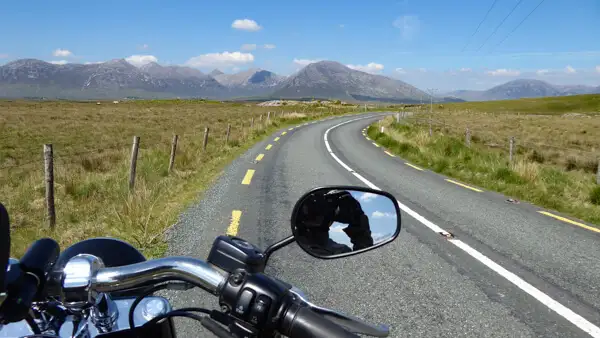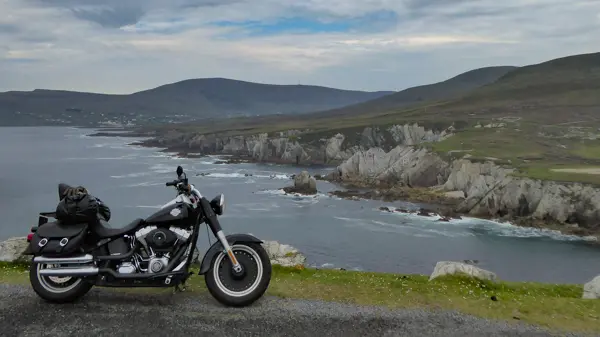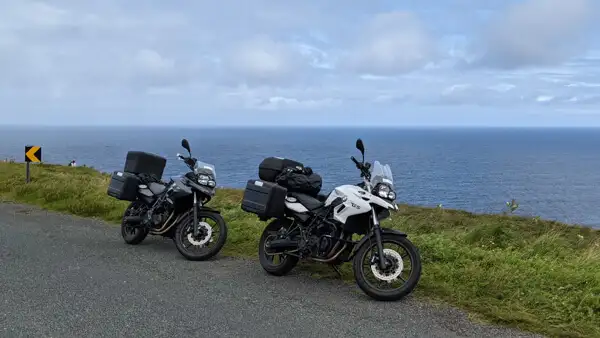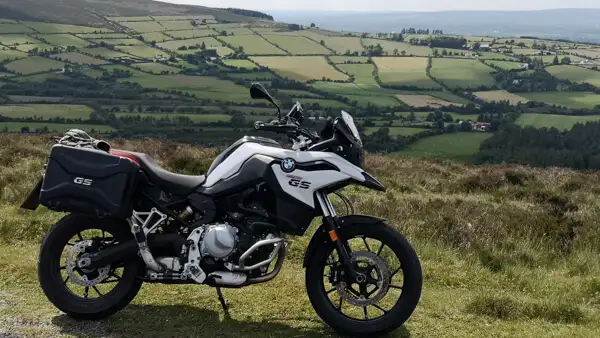The bike is well maintained and prepared with the most expensive components, the equipment is ready, now nothing can go wrong, right? And are you also prepared?
Yes, the accommodation and the ferry are booked, not bad!
But as a rider, are you properly equipped, well informed and physically and mentally fit for what’s coming up?
What do you actually have to expect? That’s what this is all about:
Page Contents (click line to jump the text)

Sources of travel stress – how to recognise them and what to do about them
I slept badly. Again. The last hotel had a wedding going on and the B&B before last was in the middle of town – on the noisy main street.
Breakfast was sumptuous, but by now it’s afternoon and I haven’t found anything for lunch.
A break and something to drink would be nice, but half the way is still ahead of me and I want to arrive before dark. No time for breaks. I don’t care about the next castle, I’ve had enough for today.
My back has been hurting for a while, the stupid helmet is pressing on my ears and the damn visor is constantly fogged up by the rain….
Oh shit, that was close, where did the car come from all of a sudden? …….
Does this look familiar? It certainly does to me.
If you overdo it, underestimate the distance, are inappropriately dressed, dehydrated and hypoglycaemic, you haven’t paid enough attention to yourself on the road and are well on the way to considerably increasing your personal risk of an accident!
Add to that imponderables such as lack of sleep, heat, cold or poor visibility and your concentration is gone.
Dangerous? Yes!
However, with good travel preparation, suitable clothing, physical fitness and the healthy measure of “listening to your body”, you can at least minimise many of the risks of a motorbike trip, even if you can’t completely eliminate them.
I have put together a few recommendations from many kilometres of my own experience.
By the way, I run a motorbike rental company in Ireland (update: I did – shop is closed now) and have driven many thousands of motorbike kilometres there (sometimes too many).
Experience is the sum of one’s mistakes, isn’t it? Yes, exactly…
Choosing a motorbike helmet
A motorbike helmet has to be able to do a lot. In the heat, it should ventilate well, but it should still be quiet. And it should insulate well in the cold.
It helps safety enormously if the helmet is clearly visible in traffic – you bought a black helmet? There are also reflective stickers you can put on it. If you’re passing through France on your journey, you should know that these are compulsory there, as is a high-visibility waistcoat.
Older visors often have a lot of micro-scratches from wiping and cleaning – they then tend to glare in direct sunlight. A new visor for travelling is certainly a good investment. If you ride in spring or autumn, you might want to add a Pinlock inner lens to prevent fogging. In summer, the inner lens may not be absolutely necessary, but it’s not a mistake. Oh yes, a microfibre cloth and visor spray are also great on the road!
If you don’t have a sun visor on your helmet, it’s best to take a pair of sunglasses that fit flat and snugly under your helmet. You wear glasses? Then you’ve probably tried to make sure that your glasses don’t pinch under your helmet – even on longer rides.

But above all, you want the helmet to be comfortable even after several hours of riding a day. The only thing that helps is to try it on patiently and to break it in well before the motorbike trip.
Trying on a helmet in a specialist shop: If your gut tells you that the helmet is too tight or pinches, and the shop assistant says “it has to be like that, it’s still wearing in”, then listen to your gut. The helmet only wears in a little, it basically has to fit when you try it on.
I haven’t said anything about the type of helmet: full-face helmets, flip-up helmets or travel enduro helmets are best suited for a trip to Ireland. I also did long tours in the summer with a half-shell helmet and sunglasses underneath. However, it had a full visor that kept the rain and wind off your face and neck.
The best motorbike suit for travelling
Often a lot of importance is attached to the motorbike jacket, then a pair of street jeans is worn underneath and there is not much money left for the rest of the clothing.
I now set my priorities differently: treat yourself to the high-quality suit if you have the money to spare, otherwise the cheap motorbike suit will do – in combination with a completely waterproof (not breathable) rain suit. But don’t neglect the legs, the motorbike trousers are a must! If it has to be jeans, at least take abrasion-resistant motorbike jeans with protectors.
Black always goes – that may be true for other occasions, but it’s careless when riding a motorbike. In bad weather, no motorist will see you in a black suit – a little colour and reflectors help enormously!
In addition, the motorbike suit must be comfortable, especially on long riding days! A plea to all those who like to look smart and figure-hugging in a motorbike suit: Nobody cares but you!
After a few hours, the suit pinches everywhere and then the poor comfort reduces your concentration. Also, the trousers tend to slip up over the boots – take one size bigger!
The suit doesn’t necessarily have to have an inner suit – a fleece jogging suit or a second layer of good thermal underwear works well. But if the suit has a lining, it should be removable on hot days!
Boots and gloves
Fortunately, we did save some money on the motorbike suit, so we still have money left over for really good motorbike boots.
Why? They get a lot of water on rainy rides and should be really waterproof, otherwise the tour can be unpleasant. There are also rain covers, I have tried them on several tours and I am not happy with them. Better to buy good boots once.
The same applies to gloves: It’s hard to imagine why the little things can be so expensive, but if – like me – you’ve spent many hours riding in wet and cold gloves, you’ll be happy to invest in some good waterproof and lightly lined gloves.
For warm days you can take a pair of light summer gloves with you, they don’t have to be expensive and then you can change on the way.

Small but important accessories
A cold neck is a stiff neck and can lead to headaches, which – exactly – reduce concentration when riding!
On my tours I always have several tubular neck scarves (Buff) with me, then I can change if one gets wet in the rain and I can put several on top of each other if it’s cold. There are also other types of collars and neck warmers – just see what works for you.
I always ride with a kidney belt, a warmer one in winter and a thinner one in summer. The wind likes to find its way under the jacket and a cold lower back is uncomfortable.
Thermal underwear is often underestimated: it helps enormously to keep the body dry and warm. The price range is up to you, but I recommend at least one pair of long underwear, some good warm thermal socks and one or more fleece shirts to combine. Wool is good, synthetic fibre is good, but cotton is only good for warm or hot days.
Sunglasses are usually included in summer, as well as sunscreen – yes, it does get 25-29 degrees in Ireland sometimes with cloudless skies!
A cap or a beanie is also in my luggage, against sun or cold wind, if the helmet is not on the head.
I only needed a mosquito repellent in the summer in Scotland, where the small biting flies (midges) bite quite aggressively. In Ireland this has not been an issue so far.
Raingear / Wetsuits
If you have a good quality rain suit with a really waterproof membrane, it will be enough for the trip. Have you tested it? Try riding deliberately for a few hours on a nasty rainy day at home, then you’ll know more. A small shower is not enough as a test scenario!
Most suits today have a climate membrane. There is almost always a sticker that says “waterproof” – and in most cases you can safely forget it!
If you have chosen a suit in the cheaper to medium category, you can buy a rain suit to go with it. It shouldn’t be breathable, but 100% waterproof, otherwise you’ll buy the same useless membrane twice.
Another free tip: The cheap all-season membrane suits can get too sweaty in hot weather in summer, because the ventilation is usually rather small. Heat build-up leads to heat stress, which reduces concentration while riding!
For summer touring you can alternatively buy a strongly ventilated summer suit (without membrane) and a rain suit to put over it, then you are very flexible and well equipped.
Limited budget – what has priority when it comes to motorbike clothing?
That is of course your decision. I find that a cheap motorbike suit can be combined well with a cheap rain suit – and then work well for the trip to Ireland.
Wet and cold boots and gloves are difficult to compensate for, which is why I now place more emphasis on these.

I don’t compromise on the helmet. It has to fit 100% and be of decent quality. Is that the most expensive helmet then? Not necessarily, there are also very good helmets in the medium price range.
Thermal underwear and fleece shirts have also become more important on my shopping list. They usually warm more than the linings of many suits, or complement them.
Am I physically fit as a driver? Self-test and preparation
Riding a motorbike is not a sport – or is it? Anyone who goes on long tours knows how strenuous they can be. Motorcycling is definitely an outdoor activity where we are exposed to the climatic conditions much more than car drivers can imagine. Riding is also more active and demands more concentration and body coordination than driving a car.
Those who hardly drive all year and do little sport could then quickly reach their physical limits during the big summer tour.
Why not test yourself? Can you still manage a short jog? How many push-ups, sit-ups and squats can you do? If that’s not your thing, then maybe yoga, walking or cycling will help? Whatever you do – but do it!
How many hours can you ride? Don’t just do the 2-hour home circuit – do it twice in a row! Yes, you’re allowed to take breaks – you’ll take them when you’re travelling. Do a weekend ride with an overnight stay, or find a more distant destination for a long day ride. Test your limits – and then expand them.
Am I well informed? What should I know before the trip?
There is also mental stress. This arises when something doesn’t go according to plan and plan B is still completely unknown. But you can think through some of these scenarios beforehand:
The daily stage is too long: In Ireland, the most beautiful routes usually lead in long loops along the rugged coasts. You can usually shorten them and drive directly to the hotel you have booked. This way, 250km quickly becomes 70km, which is easily manageable. National roads (N) are usually better developed than the small R and L roads. So you can also take shortcuts.
About booking accommodation: In spring and autumn you don’t necessarily need to book in advance. This way you stay flexible. But it can be stressful not to have found a place to stay in the afternoon. I always book a night in advance, then I can relax and still adjust the course of the trip.
In summer, it’s better to book all your nights in advance, because then it can get crowded on the coasts.
Don’t plan too much distance. Our customers (motorbike rental in Ireland: www.easycruiser.tours) usually drive barely 200-250km per day on the small narrow roads. Halfway around the island takes a week. For the whole Wild Atlantic Way you can plan at least 10 or 11 days and once around the island takes at least 14 days.
If you can easily manage that, you can add an extra lap every day. But don’t plan too much, then you’ll always feel you can do it well and won’t stress yourself out unnecessarily – on holiday!

Staying fit on the road
The first few days fly by, then tiredness sets in. Skiers know this too, on the 3rd or 4th day the falls come.
I have a few tips for you to prevent this from happening:
Make sure you get a good night’s sleep: When I book accommodation, I check the location of the B&B or hotel on Google Maps in the satellite view. I avoid city centres, motorways, major roads and neighbouring railway lines. Street View also helps to check out the neighbourhood beforehand.
Restrained alcohol consumption is also more important for a good night’s sleep than you might think! You won’t be able to get back on your bike after extensive beer and whiskey tastings!
You should also be very careful with other substances, such as medicines or similar, and avoid them.
Eating regular, but not too heavy meals and drinking plenty of water will keep your body fit. Irish food is hearty, so try to keep it in moderation and make a conscious effort to eat fruit, vegetables and salads.
Dehydration is the insidious enemy of concentration: I always have a bottle of water on board, which I also buy regularly.
In the meantime, I take shorter breaks more often. Take off the helmet, drink a sip of water, eat the apple or banana – that only takes 5 minutes and keeps the water and sugar level in the blood stable – and thus maintains performance. I skip the heavy lunch for this and eat a warm meal (not too late) in the evening.
Enjoy the journey well prepared and remain flexible
If you don’t overdo the planning and leave room for changes of plans and breaks, you can travel in a relaxed manner, even if the stage takes longer. Go with the flow!
Well-chosen, comfortable helmets and clothing help you cope well with cold or heat on long days.
Well-booked is well-bedded – and quiet too.
Eating and drinking consciously and taking regular breaks will help you keep up a good travel rhythm.
And because you have ridden regularly before and are physically fit to some extent, you will be able to enjoy your motorbike trip to Ireland to the full!
I wish you lots of fun on your trip!
More interesting articles for you
PREPARE YOUR BIKE FOR A TRIP TO IRELAND – BE WELL PREPARED AND SAFE ON THE ROAD!
56 TIPS FOR PLANNING AN UNFORGETTABLE MOTORBIKE TRIP TO IRELAND!
IRELAND MOTORBIKE TOUR – 24 BEAUTIFUL BEACHES ON THE WILD ATLANTIC WAY
I’M PACKING MY BAGS AND TAKING WITH ME… THE PACKING LIST FOR YOUR MOTORBIKE TRIP TO IRELAND!
Photo credits cover photo: Motorbike at the coast of Connemara, photo by Ulrich Knüppel-Gertberg (www.irland-insider.de, www.ireland-insider.com)